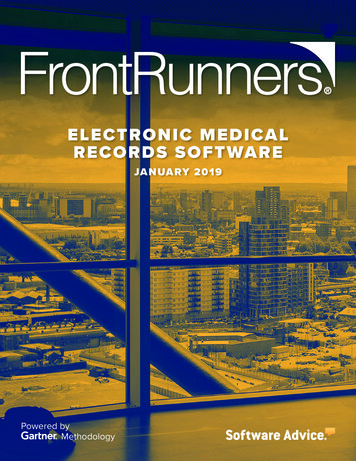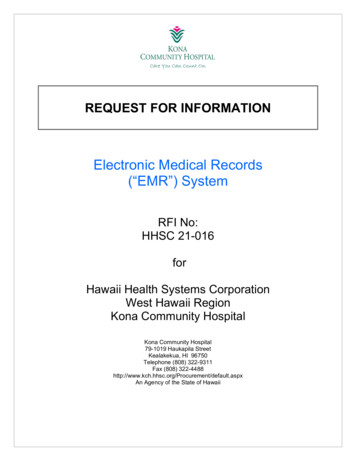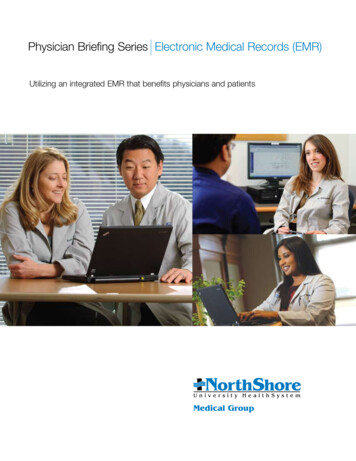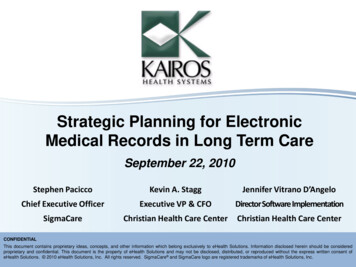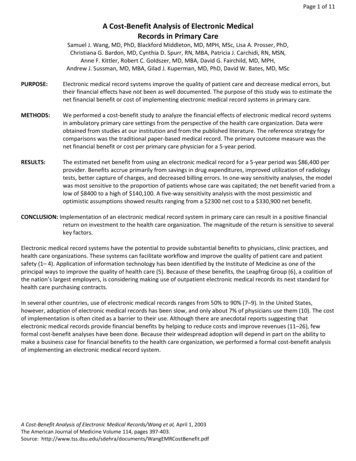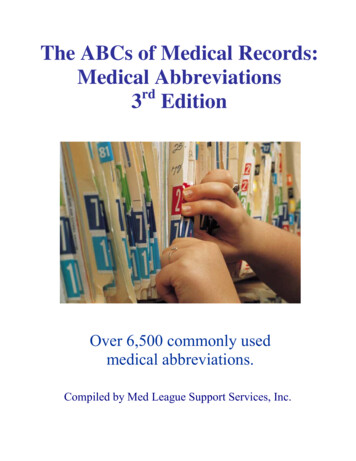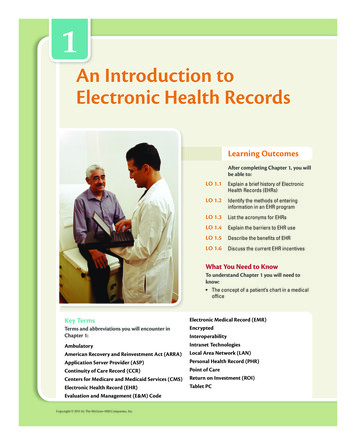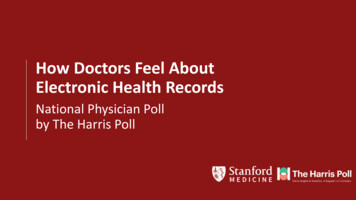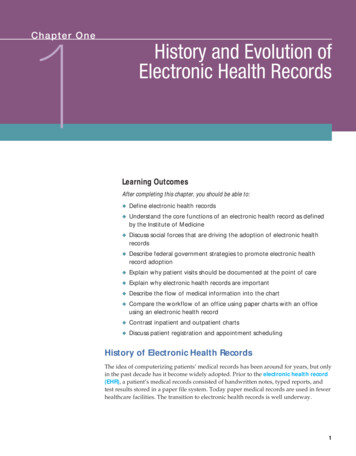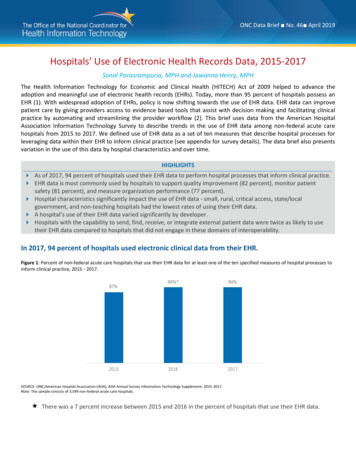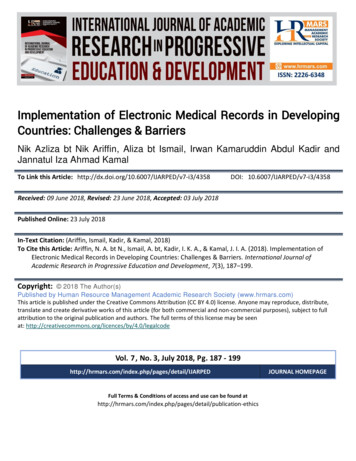
Transcription
Implementation of Electronic Medical Records in DevelopingCountries: Challenges & BarriersNik Azliza bt Nik Ariffin, Aliza bt Ismail, Irwan Kamaruddin Abdul Kadir andJannatul Iza Ahmad KamalTo Link this Article: http://dx.doi.org/10.6007/IJARPED/v7-i3/4358DOI: 10.6007/IJARPED/v7-i3/4358Received: 09 June 2018, Revised: 23 June 2018, Accepted: 03 July 2018Published Online: 23 July 2018In-Text Citation: (Ariffin, Ismail, Kadir, & Kamal, 2018)To Cite this Article: Ariffin, N. A. bt N., Ismail, A. bt, Kadir, I. K. A., & Kamal, J. I. A. (2018). Implementation ofElectronic Medical Records in Developing Countries: Challenges & Barriers. International Journal ofAcademic Research in Progressive Education and Development, 7(3), 187–199.Copyright: 2018 The Author(s)Published by Human Resource Management Academic Research Society (www.hrmars.com)This article is published under the Creative Commons Attribution (CC BY 4.0) license. Anyone may reproduce, distribute,translate and create derivative works of this article (for both commercial and non-commercial purposes), subject to fullattribution to the original publication and authors. The full terms of this license may be seenat: deVol. 7, No. 3, July 2018, Pg. 187 - DFull Terms & Conditions of access and use can be found tion-ethicsJOURNAL HOMEPAGE
International Journal of Academic Research in Progressive Education andDevelopmentVol. 7 , No. 3, July 2018, E-ISSN: 2 2 26 -6348 2018 HRMARSImplementation of Electronic Medical Records inDeveloping Countries: Challenges & BarriersNik Azliza bt Nik Ariffin, Aliza bt Ismail, Irwan Kamaruddin AbdulKadir and Jannatul Iza Ahmad KamalFaculty of Information Management, Universiti Teknologi MARA, UiTM Selangor, MalaysiaAbstractThe advancement of technology has changed the way the entire of healthcare industry functions.An electronic medical record is one of the advancement of technology that is significantly andgives a great benefit in medical field. The development of electronic medical record can help toincrease the productivity and profit of medical institutions. Most countries in developedcountries are increasingly using an electronic medical record (EMR) to improve work process,patient safety and quality of healthcare. Unfortunately, most developing countries address manydrawbacks and barriers in implementing EMR. The primary thrust of this paper is to examine thechallenges and benefits of an EMR and its contribution to the development of healthcare deliveryin developing countries. Some benefits of an EMR system to promote better health care byimproving all aspects of patient care and encouraging healthy lifestyles among communities,increase efficiencies and lower health care costs and enhancing in clinical decision making.Despite of EMR challenges facing the developing world such as interoperability, privacy andconfidentiality, organizational and social barriers, limitations of technology, electronicpreservation, legal status of EMR and customization. The potential of EMRs will make significantlyaugmentation to health care transformation. Most studies shown how workable it could be withsupport and enlighten from developed nations to design and implement an EMR system that fitsinto this setting.Keywords: Electronic Medical Record, Healthcare, Developing Countries, InformationManagementIntroduction“Paper records are increasingly becoming obsolete and inadequate. They limit the flow ofinformation, insufficiently document patient care, impede the integration of health care delivery,create barriers to research, and limit the information available for administration and decisionmaking.” (Roy Romanow, 2002)188
International Journal of Academic Research in Progressive Education andDevelopmentVol. 7 , No. 3, July 2018, E-ISSN: 2 2 26 -6348 2018 HRMARSThe awareness of health care quality has been growing for many years and this has beensignificant issue to the Ministry of Health (MOH) Malaysia. One characteristic that needs to beconsidered in improving quality of health care is records management. With the shift intechnology, implementation of electronic medical records (EMR) is arising and thus, evolving thehealth care environment.The phrase EMR itself has underwent changes which set out from “computer stored medicalrecords” subsequently computerized patient record (CPR), computerized medical record (CMR),computer-based patient record system (CBPR), electronic health record (EHR),and automatedmedical record (AMR) (Fisher,1999).Under The Seventh Malaysian Plan (Government of Malaysia, 1996) EMR systemimplementations in Malaysia started out in the year 1999. Since then the system commenced inphases throughout the country. At present, 21 out of 138 public hospitals which made up 15.2%public hospitals implemented the system (Ismail et al, 2015).The use of information technology (IT) implemented in EMR is now widely accepted in hospitalsas well as clinics. This technology based improvement, is seen to make better exchange ofinformation and bring out more effective communication among doctors. Implementation ofEMR is also seen as a promising IT based solution in health care quality improvement (Gastaldi etal, 2012). This is due to the competency of EMR system to handle large amount of informationand data within the health system and hence capable of supporting the diverse needs of clinical,organizational and management of health care (Reina et al, 2012).The EMR system integrates clinical data, patients’ records, decision support applicationprogrammes and transaction processes within a hospital. With these integration, the system hasa potential big impact on the hospital performance (Gastaldi et al, 2012). From a doctor’s pointof view, EMR allows a better way to collect, store, retrieve and analyze medical information. Theanalyzed information can then be used to seek the best treatment for a patient and in turnprovide a quality care for the patient (Richards, et al 2012). With schematic connections andinterdisciplinary understanding, EMR implementation will be able to provide effective andefficient patient, physician and clinic management as well as enhancing good outcome.Traditional Paper Based Record Keeping.Historically, paper based of medical records have been used for centuries. By using paper recordshave many advantages of being simplicity, low implementation cost, wide spread acceptance,mobile and can entry of subjectivity data. However, yet paper records have many limitations; aspaper records is a very fragile medium that requires a big space purposely for storage and it mustbe properly organized and can be accessible, data recorded may not in a uniformity standard ,only one person can access at a time, papers may be missing or lost, misplaced or it lead tocomplexity and unmanageable, frequent illegibility in clinical notes, lack of capacity to beaccessed remotely or cannot be accessed across different locations(Sridhar GR et al,2009),growing so thick more than hundred pages and involving with different volumes and variousstorage sites. The most significant problem dealing with paper records is about timing process189
International Journal of Academic Research in Progressive Education andDevelopmentVol. 7 , No. 3, July 2018, E-ISSN: 2 2 26 -6348 2018 HRMARSand usually medical professionals need the patient data instantly and time is very critical inhealthcare organizations. Paper is not a stable media format, and by nature easily affected toboth water and fire. All medical records need to be locked in a storage area in order to protectconfidentiality, integrity, and security of the information.Transition from Paper-Based to EMR systemsConversion all the information in paper medical records to electronic medical records providessignificant clinical and operational benefitsA successful transition from paper-based to electronic medical records (EMRs) in the healthcareorganizations require careful supervision and coordination of many aspects. A manifold ofdrawbacks and big decisions must be made and it begins from selection and implementation,training and maintenance. The transition involves not only the process changes but also the usingof a new tool technically and procedural training and lead changes to roles of healthcareprofessionals within the office. (College of Physicians and Surgeons of Alberta Guideline, 2005)EMR adoption will not success if they fail to evaluate the clinical workflows and informationneeds and lack of planning during and after go-live and the result of this will fall back to paper.To make it successful, the practice must fully understand the expected advantages and mustanalyze each of the choices to ensure the whole practice workflow is considered (Ronald A. et al,2010)Electronic Medical RecordsAccording to Thielst (2007a) information technology adoption in hospitals provides safer, moreeffective and efficient in healthcare delivery systems that transforms healthcare. Technology maybe effectively used in health care industry to improve procedures, common practice, regulations,public standards and protocols to produce great patient outcomes and enhanced patient safety.IT becoming a key driver of effective business and clinical enterprises.The advancement of electronic medical record (EMR) technology have made it possible for theEMR to replace many functions of the traditional paper chart, and use of EMR systems promisessignificant advances in patient care.(Institute of Medicine,1997)An electronic medical record (EMR) exists in electronic version of the paper-based record. It is acomputer-based system for storing, organizing, and retrieving information about patients, holdstremendous expectation for improving the quality and safety of healthcare. An electronic medicalrecord (EMR) can embrace much information such as name in full, complete address, date ofbirth, gender, person to notify in an emergency, insurance, medications details of present andpast history, allergies, laboratory and test results; immunization, medical surgical, andhospitalization history; as well as the documentation of the patient’s progress assessment, vitalsigns, plan of care, education and research that can be accessed from various sites within thehospital under the protection of security, patient privacy and confidentiality.190
International Journal of Academic Research in Progressive Education andDevelopmentVol. 7 , No. 3, July 2018, E-ISSN: 2 2 26 -6348 2018 HRMARSThe term of EMR defines as a computerized medical records that can be accessed from variousintegrated system at any point of care within the health care enterprise with concerned of patientprivacy, confidential and security. (Wagner, 2004).Electronic medical records (EMRs) exist in electronic format instead of paper (Sridhar GR etal,2009).The situation before using this new technology was huge different from the effects afterits implementation. The situation before EMRs implementation, manually patient record keepingin paper records format. As much of the information in the paper based records was hand writtenand usually difficult to read, transcribe, and understand as it written by healthcare professionalsthen it leads to medical errors. “High failure rates towards paper-based systems for informationstorage and retrieval that can lead to duplication of services, delays in treatment, increasedduration of stay in hospital and increased errors in medical due to absence or inaccessibility ofdata” (Crane & Raymond, 2003) By having electronic medical record system as a tool to facilitatea centralized patient information repository and to provide documented records of care thatsupports present and future care by the healthcare professionals and also as medium ofcommunication among healthcare professionals contributing to the patient’s care.Models of Successful EMR ImplementationHealthcare is moving forward to a new paradigm shift in health information technology. The needto transform the developing countries healthcare system by implementation of electronicmedical record system’s functions and features leads the healthcare industry into the new era of21st century.Australia, England, New Zealand and the Netherlands are countries that showed success in EMRimplementation. (Kidd MR & Mazza D,2000) But the most tremendously success is Australia asresults have been most dramatic. In May 2000, majority of clinicians in their practice were usinga computer in their consulting room to write the prescriptions, compared with only 15% ofgeneral practitioners reporting computer use for any purposes in October 1997.(Kidd MR &Mazza D,2000)Australia achieved this noteworthy transition by providing general practitioners with financialsupport to help them purchase a computer, supporting system implementation for those whoneeded it, and offering incentives for those using electronically in their practices. England hasmade greater development, albeit more slowly. Currently, 98% of general practitioners haveaccess to an EMR on their desktop. Nearly all use it purposely for prescription refills, and 30%report that their practices are paperless.Advantages Of EMR In Developing CountriesElectronic medical records are the surge of the future. EMRs represent an attempt to translateinformation from paper records into a computerized format. Electronic medical records areexpected to provide a wide range of advantages to healthcare industry (Fraser HSF et al, 2005).EMRs offer many potential advantages over traditional paper-based records and it is the first stepto transformed health care. This electronic medical record is very readable, thus eliminatingerrors often made when transcribing hand-written information.191
International Journal of Academic Research in Progressive Education andDevelopmentVol. 7 , No. 3, July 2018, E-ISSN: 2 2 26 -6348 2018 HRMARSImproving patient care and safety was stated as the main factors driving the need for EMR.Mainly addressed to increase efficiency, accuracy, accessibility, and safety that EMR will bring tothe healthcare organizations.In an ideal situation, the electronic medical record (EMR) is an enabling technology that focus onimprovement in quality management. Basically, it concerns on streamline the work processesand accountability, improved results management and patient care with a reduction in errorsand legibility of records. According to Lamont (2005), almost 70% medication problems improvedwhen EMR is implemented.In clinical productivity, although EMR in a single entry but it provides multiple use for healthcareprofessionals in hospital. Electronic medical records have the capability to capture and store ahuge amount of patient information such a large database results in quality improvement andcost effectiveness (Sidorov, 2006). The data layout is so flexible, automatic in data capturing suchas ICU lab and also provide automatic patient chart to increase accuracy and completeness of therecord.EMR contains information only from respective hospital. Yet the ability having this informationin a structured way lead to structured data that can enhance and extend research capabilities.EMR offer the ability to improve patient safety by providing care for patients in a consistent andtimely manner in producing results, avoid duplicates and it need to be complied with clinicalprotocols standards and regulations. Improved efficiencies and lower health care costs bypromoting single patient records with integrated information to ensure continuity of care andimproved coordination of health care services, as well as by reducing waste and redundant testsThis efficiency can create better clinical decision making by integrating patient information fromnumerous sources. Sharing patient charts and medical information with other health careproviders is also easier by using EMR system as patient centeredness. In paper patient recordkeeping, still implement data analysis, capture, compilation, consolidation, and reporting but ittakes up much time as the process is conducted manually. EMR storage of data permits forimproved quality measurement and enhanced clinical research (Halamka, 2006). Once thetransition to an EMR system is completed, storage space dedicated to paper charts can beeliminated.Besides improving the delivery of health care to patients, electronic medical records can decreaseadministrative process and other related costs for clinicians. EMR implementation can optimizeresources as more workload with the same amount of people, can reduce operational costs suchas transcription services and overtime labor expenses. Likewise, medical records clerk for filingand retrieval for a patient files and the need to purchase paper based supplies is slowly reducedor eliminated. In terms of revenue enhancements, EMR provides the ability to more accuratelyand efficiently process patient billing and the exact amount of charge of every patients. Otheradvantages is the space saving of a digital records environment.192
International Journal of Academic Research in Progressive Education andDevelopmentVol. 7 , No. 3, July 2018, E-ISSN: 2 2 26 -6348 2018 HRMARSFinancially, from the aspect of micro accounting EMR system can compare performance by unit,care providers and can helps in resource allocation.Furthermore, virtually all EMR systems improves stakeholders satisfaction by improving accessto healthcare information. In administration aspect, EMR improves waiting time especially onappointment basis and scheduling. EMR provide the ability to ultimately increase the number ofpatients served per day for enhanced patient workflow and increased productivity.The various points of views about EMRs address both positive and negative remarks. EMR isconsidered as one of medium communication in healthcare delivery and it can improvestransparency and communication among healthcare professionals. EMR provides regulatorycompliance to ensure data for statistics and disease notification updated. In legal aspects, EMRsconcern on confidentiality, data integrity, access control and audit trail as implementing EMR lessprone to data loss.Challenges and BarriersWith the promising effects of EMR implementation in developing countries, more health careinstitutions began to adopt the technology. However, the widespread application of EMRrevealed many issues of dispute in the EMR system.InteroperabilityEMR system integrates all of patients’ demographic, clinical and financial data which enablesdoctors and other health care providers to share the data and make effective decisions inproviding a quality care for patients. EMR system also incorporates appointment schedules,billings, and electronic filing as well as coding in order to ensure clinic operations run smoothly.As demonstrated from above, there is a need of high level integration between the differentactivities in health care. The complexity of integrating different activities can be seen from theoperational treads interdepartmentally. Clinical department involves history taking, givingdiagnosis and planning for treatments. Supportive department includes nursing, allied healthfields and laboratory. Administrative department on the other hand observes economic, financialand legal process. Each department would require specialized and detailed technical knowledge.However, in giving care to patients, all staff from the relevant departments need to givecooperation and collaborate to give a quality care (Reina et al, 2012).With many different activities involvement, there is bound for conflicts to arise. However,without integration and interoperable EMR system, doctors, pharmacists, nurses, supportingstaff and hospital management staff could not share patients’ information, and in turn takingchances in patients’ care. The technical interdependencies require coordination of informationthat links peo
Models of Successful EMR Implementation Healthcare is moving forward to a new paradigm shift in health information technology. The need to transform the developing countries healthcare system by implementation of electronic medical record system’s functions and features leads the healthcare industry into the new era of 21st century.
